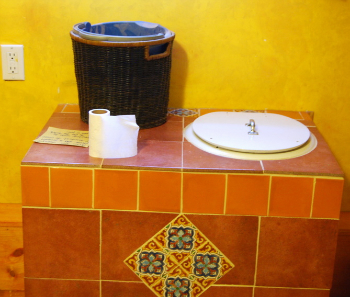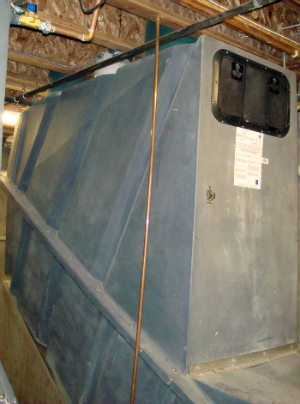Part 3 of Grist’s special series on poop.
Laura Allen, a 33-year-old teacher from Oakland, California, has a famous toilet. To be honest, it’s actually a box, covered in decorative ceramic tiles, sitting on the cement floor of her bathroom like a throne. No pipes lead to or from it; instead, a bucket full of shavings from a local wood shop rests on the box next to the seat with a note instructing users to add a scoopful after making their “deposit.” Essentially an indoor outhouse, it’s a composting toilet, a sewerless system that Allen uses to collect her household’s excrement and transform it into a rich brown material known to fans as “humanure.”
 Laura Allen’s famous composting toilet.Courtesy Nicolas Boullosa via FlickrAllen is a founding member of an activist group devoted to the end of sewage as we know it. Her toilet recently made an appearance in the Los Angeles Times — which might explain why she didn’t seem surprised when I emailed her out of the blue to ask if I could use it.
Laura Allen’s famous composting toilet.Courtesy Nicolas Boullosa via FlickrAllen is a founding member of an activist group devoted to the end of sewage as we know it. Her toilet recently made an appearance in the Los Angeles Times — which might explain why she didn’t seem surprised when I emailed her out of the blue to ask if I could use it.
Lifting the seat, she showed me a seal of insulating foam tape she’d put around its edges to prevent odors from wafting into the bathroom and then pointed out a funnel-like contraption hanging from the front of the toilet that diverted urine away from crap. The separated waste collected in two containers sitting several feet below the toilet seat, accessible through a hatch cut into the side of the house: the urine flowed into a plastic jug formerly used for olive oil, the feces into a bucket labeled “feta cheese.” A year from now, once it’s composted, Allen and her roommates will use this excrement to fertilize their fruit trees.
To most Americans, Allen’s system would seem eccentric, if not downright weird. But while feta cheese buckets are relatively new creations, humans have used shit as fertilizer since the dawn of agriculture — the nitrogen in our urine is an excellent fertilizer, and feces, itself nutrient-rich, is a great soil amendment. It wasn’t until the turn of the 20th century that water-based sewer systems became commonplace in the United States; after that, “sewer farms,” where crops were irrigated with untreated wastewater, were commonplace. Even today, the majority of the world’s population doesn’t have access to flush toilets, making us the anomaly, rather than the norm.
As public health advocates will be quick to point out, the switch to sewers helps protects us from sewage borne diseases. But it also breaks the nutrient cycle: instead of returning nutrients to the land from where they came, we now reclassify excrement as waste and use chemical fertilizers to replace it. From an agricultural standpoint, the crazy thing isn’t the idea of using our crap as fertilizer. It’s how far we’ve strayed.
With this in mind, the idea behind our current system would seem to make sense: more than half of America’s sewage sludge is applied to land. But there’s a crucial difference between humanure and modern sludge, known in the sewage industry as “biosolids.” Humanure is made from pure human excrement. It can still contain residues from pharmaceuticals that pass through our bodies, but it lacks the industrial chemicals or other contaminants that make sludge so controversial.
Biosolids, on the other hand, can count as ingredients everything that’s dumped into our sewer system, including a mixture of domestic and industrial waste that can include heavy metals, toxic chemicals, and thousands of other pollutants — and its long-term effects on soil are impossible to predict. The main ingredient of biosolids and humanure — feces — might be the same, but when it comes to their potential to contaminate soil, the two materials are fundamentally different.
It’s difficult to judge what will ultimately have worse consequences for agriculture and human health: spreading the contaminants in modern sewage sludge on soil or diverting sewage’s nutrients away from land. (Both are bad in different ways.) But one thing is certain: creating pure humanure with our current wastewater treatment system would require segregating our waste streams at their sources, which, thanks to the way our sewers are piped, is impossible to do.
Allen left me alone so that I could experience her bathroom firsthand and then took me outside to see the next step in the process. We walked through a small chicken coop to three 55-gallon barrels full of decomposing feces arranged in a row next to the side of the house, each of which would sit for at least a year in order to compost thoroughly. Covered with netting to prevent flies and plastic lids to keep out rain, they didn’t smell.
 Laura Allen with a bucket of humanure in her garden at her house in Oakland, Calif.Courtesy Nicolas Boullosa via FlickrBut then Allen reached for a compost auger — a corkscrew-like device with a hand crank that breaks apart the composting material and adds oxygen — and worked it into the compost. The air filled with the strong, unpleasant odor of methane, a byproduct of anaerobic composting.
Laura Allen with a bucket of humanure in her garden at her house in Oakland, Calif.Courtesy Nicolas Boullosa via FlickrBut then Allen reached for a compost auger — a corkscrew-like device with a hand crank that breaks apart the composting material and adds oxygen — and worked it into the compost. The air filled with the strong, unpleasant odor of methane, a byproduct of anaerobic composting.
“It must have gotten some water into it, that’s why it smells so bad,” Allen said, pulling up the auger and revealing some confused-looking earthworms. She examined the moist brown material clinging to the corkscrew. “This one’s probably about seven months old.”
Allen and her roommates’ devotion to their toilet is unusual, but they’re far from alone — a small but growing number of Americans is unhooking from septic tanks and sewer systems (or, in some cases, never hooking in) and composting their waste. If you want to get a sense of how excited people can get about the results, check out the website of a man named Joseph Jenkins. A slate-roofing contractor in Pennsylvania who’s been shitting in a bucket since the 1970s, Jenkins and his followers dream of a day where entire cities might compost their excrement, with municipal collection services similar to today’s recycling programs.
To help jumpstart the revolution, Jenkins self-published a guide in 2005 called The Humanure Handbook that features chapter with titles like “Crap Happens” and an illustrated character named “Tommy the Turd.” For his first run, Jenkins could only afford to print 600 copies; he’s now sold more than 33,000, and portions of the handbook have been translated into Spanish, Norweigan, Korean, Hebrew, Mongolian and Chinese.
The challenge these simple systems face, however, is that most Americans don’t like the idea of homemade toilets. We don’t like thinking about our shit, period. So a middle ground has emerged: commercially designed toilets that look what you’re used to, but have composting systems built in.
The BioLet, originally a Swedish design, includes a heater to speed decomposition and aerates its contents with mechanized arms. The Sun-Mar has a built-in crank and a removable tray that catches finished material. The Ecotech, the American version of a design by a Norweigan company called Vera Miljö, uses a carousel system — sort of like a lazy Susan — to keep batches separate so that new waste doesn’t mix with old. Biolytix, an Australian wastewater treatment system designed to fit into a conventional septic tank, comes pre-seeded with an ecosystem of worms, beetles and microorganisms that filter and break down waste.
Bio-Sun, Envirolet, Aquatron, Equaris, Phoenix — like “biosolids,” they all manage to sound vaguely green while avoiding any allusions to the substance they’re meant to treat. Talk to people who have owned them, though, and there’s no getting around that what you’re dealing with is shit. With a typical toilet, all you need to do is flush; with a composting toilet, everything you produce stays right where you left it — and some of these commercial designs, while tempting, aren’t big enough to handle daily use. (Horror stories abound.)
 Joseph Jenkins sells his book online, and he has posted a series of instructional videos about humanure on his YouTube channel (watch one below).Courtesy Jenkins PublishingSuccessful composting, while not rocket science, requires attention, devotion and considerable knowledge of the process; far from being an informational brochure, The Humanure Handbook, is 255 pages long. The environmentalist in me wanted to embrace the idea behind Allen’s toilet — really, I did — but when it came to dealing with my own excrement, I was like most Americans: the only time I wanted to look back in the bathroom was to flush.
Joseph Jenkins sells his book online, and he has posted a series of instructional videos about humanure on his YouTube channel (watch one below).Courtesy Jenkins PublishingSuccessful composting, while not rocket science, requires attention, devotion and considerable knowledge of the process; far from being an informational brochure, The Humanure Handbook, is 255 pages long. The environmentalist in me wanted to embrace the idea behind Allen’s toilet — really, I did — but when it came to dealing with my own excrement, I was like most Americans: the only time I wanted to look back in the bathroom was to flush.
To find out if there were any way to create a composting toilet that wouldn’t make an average American recoil in disgust, I traveled to Bainbridge Island, a 35-minute ferry ride from Seattle. My destination was IslandWood, an outdoor learning center tucked into 255 wooded acres of a former tree farm that’s home to one of the country’s only large-scale composting toilets. Known as the Clivus Multrum M-15, this particular system can handle up to 36,000 uses per year.
When I reached IslandWood, I was welcomed by Brian Bonifaci, the man responsible for maintaining the Clivus system. Dressed in Carhartt clothing from top to bottom, Bonifaci led me to the basement room where the compost was collected in two large, gray boxes. With sloping floors designed to make it easier to remove finished material, each bin was nearly 10 feet long and over seven feet high, with thick black pipes connecting them to four toilets sitting directly above.
After showing me a trap door where finished compost could be removed, Bonifaci opened a hatch on the upper part of the box so that I could see what was inside: a giant mound of feces, toilet paper, and wood chips. It was level except for an upside down cone that had formed where the most recent deposits had dropped. But even though my face was practically in the box, I couldn’t smell its contents — an exhaust fan was constantly pulling fresh air into the bin and out a vent on the roof so that no odors could leak into the room where I was standing. (The same fan also pulled air down the toilet so the smell couldn’t escape upwards into the bathroom.)
“What do you need to do to maintain this?” I asked Bonifaci.
“I add a bucket of wood chips once a week and rake down the cone when it gets too high,” he said. “That’s about it.”
He explained that the fan helped aerate the pile, eliminating the need to turn the compost, and an automatic moistening system added just enough water to keep the material from getting too dry. Eventually, Bonifaci told me, they’d have to remove some of the compost from the bottom of the pile, but so far they hadn’t had to, despite the fact that they’d installed the toilet in 2002 — composting dramatically reduces the volume of waste.
But then again, IslandWood’s facilities weren’t exactly getting their maximum 36,000 uses per year — Bonifaci told me that some campers, fearful about the toilets’ gaping black holes, simply held it till they got to a different building. So I called Don Mills, the sales director for Clivus Multrum, to find out more about what these systems’ capacities really were.
 A metal composting bin that is part of the Clivus Multrum at IslandWood.Catherine PriceMills, who refuses to use the word “biosolid” unless he can add in a “so-called” before it, has strong opinions on the current way America deals with sewage.
A metal composting bin that is part of the Clivus Multrum at IslandWood.Catherine PriceMills, who refuses to use the word “biosolid” unless he can add in a “so-called” before it, has strong opinions on the current way America deals with sewage.
“I’m calling that shit ‘sludge’ until I die,” he announced when I used the word “biosolids” without his preferred modifier. “And I might die from it!”
He then launched into a tirade against land application. But when the subject switched to composting toilets, Mills became cautiously optimistic.
“Look,” he said. “Selling composting toilets is an uphill struggle, partially because of the psychology around shit and also because of regulations.”
But once you sell people on the idea, said Mills, “there’s no capacity limitation with this technology. We can build it for as many people as would need to use any toilet, any place.” If a bathroom is meant to serve more people than a single Clivus Multrum system can handle, you just add more bins or toilets. Clivus Multrum has a system installed at the Bronx Zoo, for example, that’s designed for over 500,000 uses a year.
Mills explained that there are ways to make composting toilets less offensive — Clivus Multrum already has models that use a small amount of foam to “flush” the excrement to a hidden holding tank, which means the toilets don’t have to sit directly over the composting bins and users don’t have to look down onto a giant mound of shit. Less hands-on customers than Bonifaci can also contract Clivus Multrum to maintain the toilets for them.
“If this were something that were supported by the government,” Mills said, “if the compost toilet was made a requirement, then many things would change.” Toilets would be designed to be even more palatable to non-environmentalists, he said, and large-scale municipal collection systems would evolve to get the compost out of the toilets and onto fields.
Mill is not entirely optimistic — like me, he doubts that composting toilets will become mainstream in America any time soon. Manhattan’s skyscrapers weren’t built with humanure in mind, and as he himself admits, “the dry toilet at IslandWood is not something most homeowners would regard as satisfactory in their dream house.”
But there are plenty of places in the world not yet hooked up to sewer systems — in fact, an estimated 2.6 billion people don’t even have access to toilets. Just as many developing countries adopted cell phones without ever having built the infrastructure for landline phones, poor communities could skip sewer systems and develop an integrated system of composting toilets instead.
In India, where 18 percent of the population lacks toilets, a man named Dr. Bindeshwar Pathak, founder of the Sulabh Sanitation Movement, is helping people do just that: he’s developed a line of composting toilets that earned him the prestigious 2009 Stockholm Water Prize. According to the Stockholm Water Institute, the Sulabh Shauchalaya twin pit, pour-flush toilet is being used in more than 1.2 million residences and buildings in India, and its public facilities — spread across 7500 locations — are getting more than 10 million uses per day.
America’s a tougher market. But if composting toilets were inoffensive to use, if someone else were responsible for dealing with the compost — just as right now someone else is responsible for treating our watered-down waste — it’s possible to imagine new buildings and communities that incorporate at least some of the recycling schemes of which the humanurists dream. We probably will never eliminate American sludge entirely, but if we were able to divert even a small portion of our excrement away from the sewer system, treat it for pathogens and turn it into compost, we’d be reducing the amount left to deal with. The best solution for the future, it seems, just might be a modernized version of the past.
Back at IslandWood, I asked Bonifaci if I could try out the facilities, and soon found myself alone in the restroom. Thanks to the fan sucking air into the toilet, the only noticeable odor was a faint aura of lemongrass cleaning products and the lingering scent of lavender soap. Since the Clivus Multrum doesn’t divert urine, when I sat down, I didn’t have to aim. The biggest tangible difference between it and a conventional toilet was the breeze — which, if you’re not expecting it, can be a little surprising. But there was no odor, no wood chips, no worry that in a week or two or three, I’d be responsible for handling the waste I’d just produced.
The experience was remarkably unremarkable. It required so little thought that when I got up, I didn’t even need to turn back to flush.
—
A video on humanure composting from Joseph Jenkins’ YouTube channel:
Correction: The story was updated on May 13, 2009, to correct the description of the Envirolet toilet system. The description in the original post actually referred to the Ecotech system.



